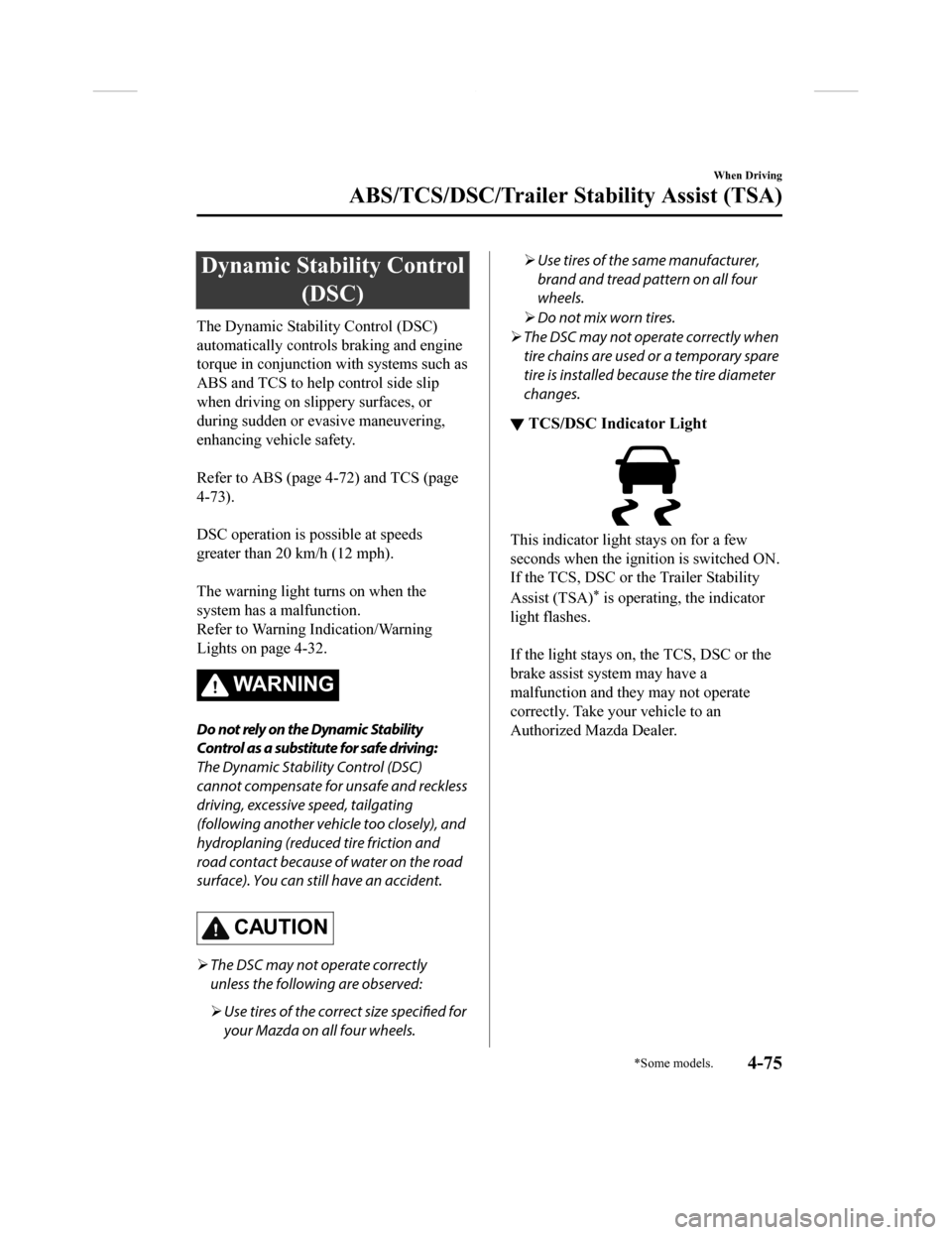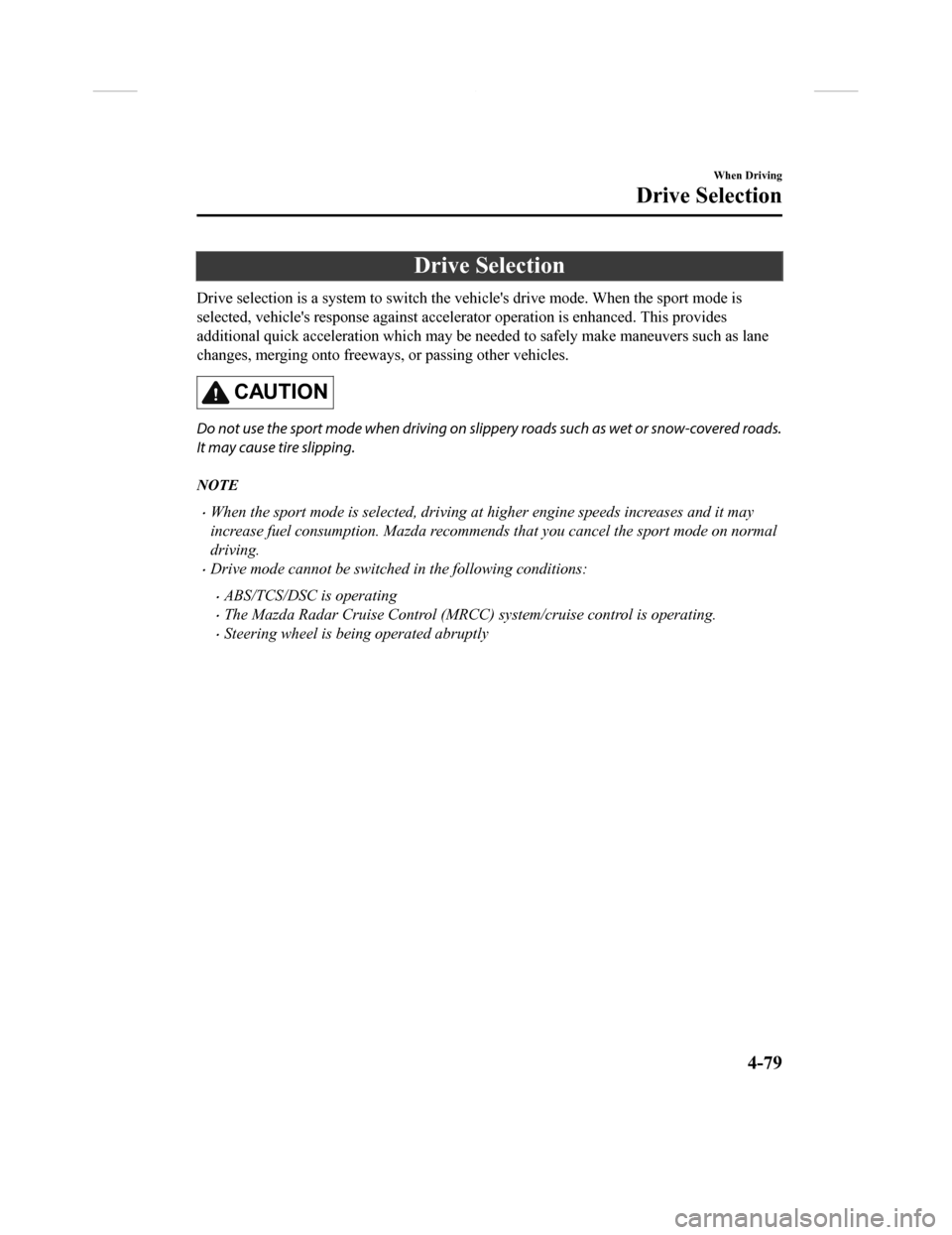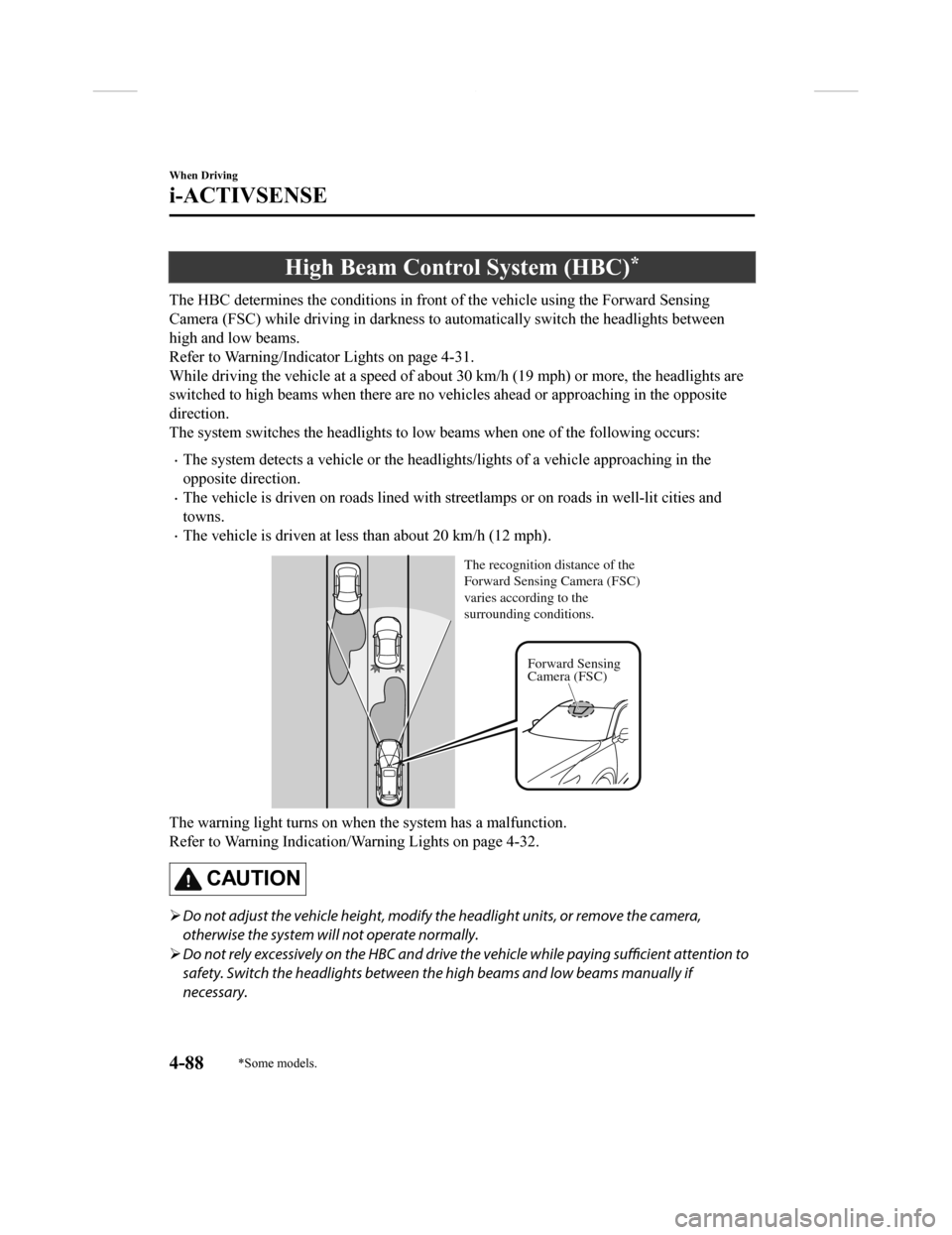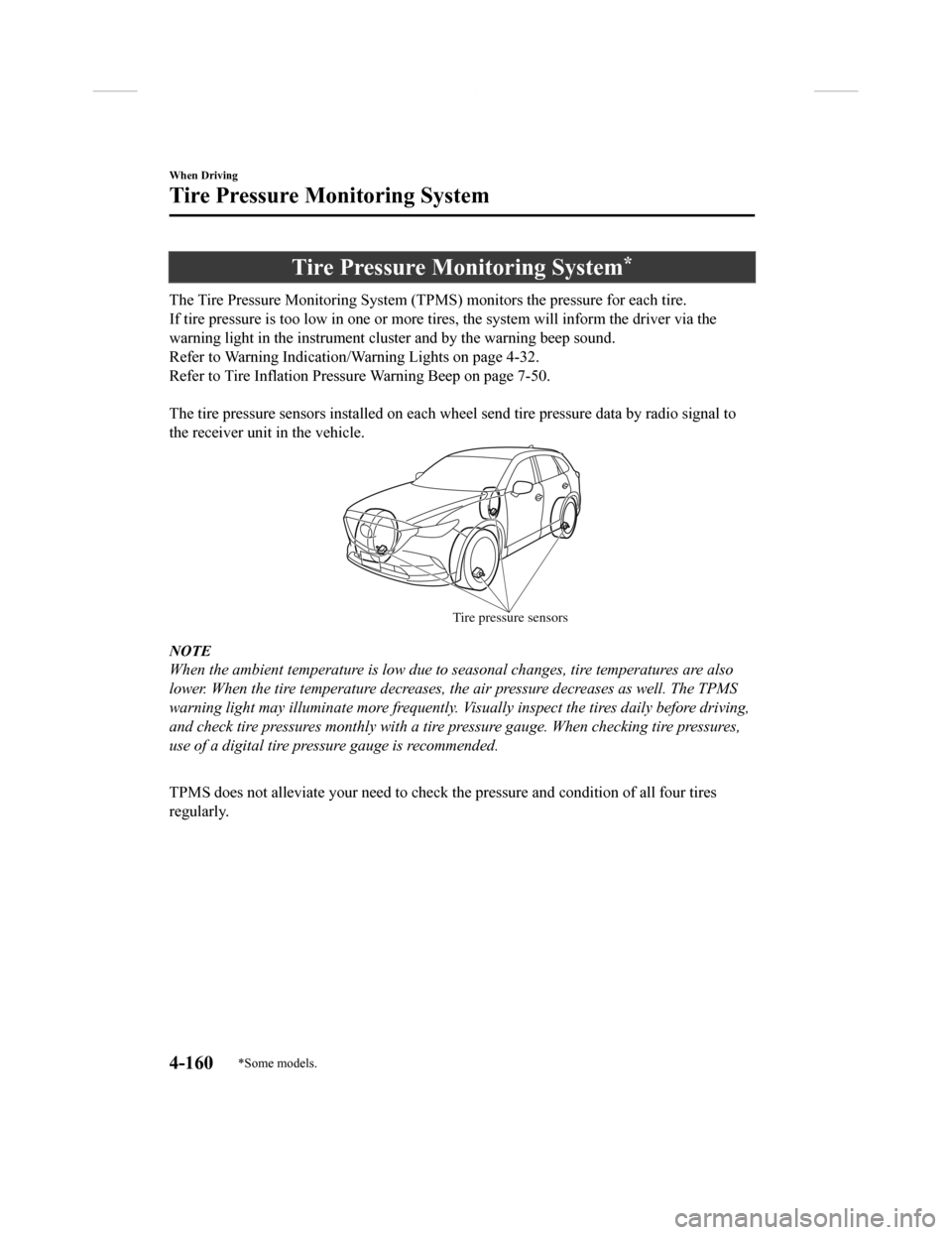ECO mode MAZDA MODEL CX-9 2018 (in English) Owner's Guide
[x] Cancel search | Manufacturer: MAZDA, Model Year: 2018, Model line: MODEL CX-9, Model: MAZDA MODEL CX-9 2018Pages: 640
Page 227 of 640

Traction Control System(TCS)
The Traction Control System (TCS)
enhances traction and safety by controlling
engine torque and braking. When the TCS
detects driving wheel slippage, it lowers
engine torque and operates the brakes to
prevent loss of traction.
This means that on a slick surface, the
engine adjusts automatically to provide
optimum power to the drive wheels,
limiting wheel spin and loss of traction.
The warning light turns on when the
system has a malfunction.
Refer to Warning Indication/Warning
Lights on page 4-32.
WA R N I N G
Do not rely on the Traction Control System
(TCS) as a substitute for safe driving:
The Traction Control System (TCS) cannot
compensate for unsafe and reckless
driving, excessive speed, tailgating
(following another vehicle too closely), and
hydroplaning (reduced tire friction and
road contact because of water on the road
surface). You can still have an accident.
Use snow tires or tire chains and drive at
reduced speeds when roads are covered
with ice and/or snow:
Driving without proper traction devices on
snow and/or ice-covered roads is
dangerous. The Traction Control System
(TCS) alone cannot provide adequate
traction and you co uld still have an
accident.
NOTE
To turn off the TCS, press the TCS OFF
switch (page 4-74).
▼ TCS/DSC Indicator Light
This indicator light stays on for a few
seconds when the ignition is switched ON.
If the TCS, DSC or the Trailer Stability
Assist (TSA)
* is operating, the indicator
light flashes.
If the light stays on, the TCS, DSC or the
brake assist system may have a
malfunction and they may not operate
correctly. Take your vehicle to an
Authorized Mazda Dealer.
NOTE
•In addition to the indicator light
flashing, a slight lugging sound will
come from the engine. This indicates
that the TCS/DSC is operating properly.
•On slippery surfaces, such as fresh
snow, it will be impossible to achieve
high rpm when the TCS is on.
When Driving
ABS/TCS/DSC/Trailer Stability Assist (TSA)
*Some models.4-73
CX-9_8GC3-EA-17G_Edition1 2017-5-29 10:13:38
Page 229 of 640

Dynamic Stability Control(DSC)
The Dynamic Stability Control (DSC)
automatically controls braking and engine
torque in conjunction with systems such as
ABS and TCS to help control side slip
when driving on slippery surfaces, or
during sudden or evasive maneuvering,
enhancing vehicle safety.
Refer to ABS (page 4 -72) and TCS (page
4-73).
DSC operation is possible at speeds
greater than 20 km/h (12 mph).
The warning light turns on when the
system has a malfunction.
Refer to Warning Indication/Warning
Lights on page 4-32.
WA R N I N G
Do not rely on the Dynamic Stability
Control as a substitute for safe driving:
The Dynamic Stability Control (DSC)
cannot compensate for unsafe and reckless
driving, excessive speed, tailgating
(following another vehicle too closely), and
hydroplaning (reduced tire friction and
road contact because of water on the road
surface). You can still have an accident.
CAUTION
The DSC may not operate correctly
unless the following are observed:
Use tires of the correct size
specified for
your Mazda on all four wheels.
Use tires of the same manufacturer,
brand and tread pattern on all four
wheels.
Do not mix worn tires.
The DSC may not operate correctly when
tire chains are used or a temporary spare
tire is installed because the tire diameter
changes.
▼ TCS/DSC Indicator Light
This indicator light stays on for a few
seconds when the ignition is switched ON.
If the TCS, DSC or the Trailer Stability
Assist (TSA)
* is operating, the indicator
light flashes.
If the light stays on, the TCS, DSC or the
brake assist system may have a
malfunction and they may not operate
correctly. Take your vehicle to an
Authorized Mazda Dealer.
When Driving
ABS/TCS/DSC/Trailer Stability Assist (TSA)
*Some models.4-75
CX-9_8GC3-EA-17G_Edition1 2017-5-29 10:13:38
Page 233 of 640

Drive Selection
Drive selection is a system to switch the vehicle's drive mode. When the sport mode is
selected, vehicle's response against accelerator operation is enhanced. This provides
additional quick acceleration which may be needed to safely mak e maneuvers such as lane
changes, merging onto freeways, or passing other vehicles.
CAUTION
Do not use the sport mode when driving on slip pery roads such as wet or snow-covered roads.
It may cause tire slipping.
NOTE
•When the sport mode is selected, driving at higher engine speeds increases and it may
increase fuel consumption. Mazda recommends that you cancel the sport mode on normal
driving.
•Drive mode cannot be switched in the following conditions:
•ABS/TCS/DSC is operating
•The Mazda Radar Cruise Control (MRCC) system/cruise control is operating.
•Steering wheel is being operated abruptly
When Driving
Drive Selection
4-79
CX-9_8GC3-EA-17G_Edition1 2017-5-29 10:13:38
Page 238 of 640

i-ACTIVSENSE*
i-ACTIVSENSE is a collective term covering a series of advanced safety and driver support
systems which make use of a Forw ard Sensing Camera (FSC) and radar sensors. These
systems consist of active safety and pre-crash safety systems.
These systems are designed to ass ist the driver in safer driving by reducing the load on the
driver and helping to avert col lisions or reduce their severity. However, because each system
has its limitations, always drive carefully and do not rely sol ely on the systems.
▼Active Safety Technology
Active Safety Technology supports safer driving by helping the
driver to recognize potential
hazards and avert accidents.
Driver awareness support systems
Nighttime visibility
Adaptive Front Lighting Sy stem (AFS)..................................................................... page 4-87
High Beam Control System (HBC)................................. ........................................... page 4-88
Left/right side and rear side detection
Lane Departure Warning Sys tem (LDWS).............................................................. page 4-123
Blind Spot Monitoring (BSM)................................................................................... page 4-91
Road sign recognition
Traffic Sign Recogn ition System (TSR).......................... .......................................... page 4-97
Inter-vehicle distance recognition
Distance Recognition Support System (DRSS)....................................................... page 4-104
Rear obstruction detection wh en leaving a parking space
Rear Cross Traffic Alert (RCTA)................................ .............................................page 4-107
Driver support systems
Inter-vehicle distance
Mazda Radar Cruise Control with S top & Go function (MRCC with Stop & Go function)
.................................................................................................................................. page 4-110
Lane departure
Lane-keep Assist System (LAS).................................. ............................................ page 4-123
When Driving
i-ACTIVSENSE
4-84*Some models.
CX-9_8GC3-EA-17G_Edition1 2017-5-29 10:13:38
Page 242 of 640

High Beam Control System (HBC)*
The HBC determines the conditions in front of the vehicle using the Forward Sensing
Camera (FSC) while driving in darkness to automatically switch the headlights between
high and low beams.
Refer to Warning/Indicator Lights on page 4-31.
While driving the vehicle at a speed of about 30 km/h (19 mph) or more, the headlights are
switched to high beams when there are no vehicles ahead or appr oaching in the opposite
direction.
The system switches the headlight s to low beams when one of the following occurs:
•The system detects a vehicle or the headlights/lights of a vehi cle approaching in the
opposite direction.
•The vehicle is driven on roads lined with streetlamps or on roa ds in well-lit cities and
towns.
•The vehicle is driven at less than about 20 km/h (12 mph).
Forward Sensing
Camera (FSC)
The recognition distance of the
Forward Sensing Camera (FSC)
varies according to the
surrounding conditions.
The warning light turns on when the system has a malfunction.
Refer to Warning Indication/Warning Lights on page 4-32.
CAUTION
Do not adjust the vehicle height, modify th e headlight units, or remove the camera,
otherwise the system will not operate normally.
Do not rely excessively on the HBC and drive the vehicle while paying sufficient attention to
safety. Switch the headlights between the high beams and low beams manually if
necessary.
When Driving
i-ACTIVSENSE
4-88*Some models.
CX-9_8GC3-EA-17G_Edition1 2017-5-29 10:13:38
Page 251 of 640

Traffic Sign Recognition System (TSR)*
The TSR helps prevent the driver from overlooking traffic signs, and provides support for
safer driving by displaying traffic signs on the active driving display which are recognized
by the Forward Sensing Camera (F SC) or recorded in the navigation system while the
vehicle is driven.
The TSR displays the speed limit, do not enter, and traffic sto p signs.
If the vehicle speed exceeds the speed limit sign indicated in the active driving display while
the vehicle is driven, the syste m notifies the driver using the indication in the active driving
display and a warning sound.
NOTE
•The TSR is not supported in some countries or regions. For information concerning the
supported countries or regions, consult an Authorized Mazda Dealer.
•The TSR operates only if the navigation syst em SD card (Mazda genuine) is inserted in
the SD card slot. Consult an Authorized Mazda Dealer for details.
When Driving
i-ACTIVSENSE
*Some models.4-97
CX-9_8GC3-EA-17G_Edition1 2017-5-29 10:13:38
Page 258 of 640

Distance Recognition Support System (DRSS)*
The DRSS measures the distance between your vehicle and a vehicle ahead using a radar
sensor (front) while the vehicle speed is about 30 km/h (19 mph ) or faster, and if your
vehicle approaches a vehicle ahead more closely than what is ap propriate for maintaining
distance between the vehicles according to the vehicle speed, a notification in the active
driving display is indicated to advise you to keep a safe dista nce from the vehicle ahead.
WA R N I N G
Do not rely completely on the DRSS and always drive carefully:
The ability to detect a vehicle ahead is limite d depending on the type of vehicle ahead, the
weather conditions, and the traffic conditions. Therefore, if the accelerator and brake pedals
are not operated correctly it could lead to an accident. Always verify the safety of the
surrounding area and depress the brake pedal or accelerator pedal while keeping a safer
distance from vehicles ahead or on-coming vehicles.
NOTE
•The DRSS operates when all of the following conditions are met:
•The ignition is switched ON.
•The DRSS is on.
•The selector lever is in a position other than reverse (R).
•The vehicle speed is 30 km/h or faster (19 mph or faster).
•The objects which activate the system are 4-wheeled vehicles.
•The DRSS may also operate in the presence of motorcycles and bicycles.
•The DRSS may not operate normally under the following conditions:
•The Dynamic Stability Control (DSC) has a malfunction.
•The vehicle ahead is traveling at an extremely slow speed.
•The system does not operate with the following objects:
•Vehicles approaching in the opposite direction.
•Stationary objects (stopped vehicles, obstructions)
▼ Indication on Display
The DRSS operation status is indicated in the active driving di
splay or multi-information
display. Regarding malfunctions, check the vehicle conditions o r have it inspected by an
Authorized Mazda Dealer according to the content of the display ed message.
Refer to Warning/Indicator Lights on page 4-31.
When Driving
i-ACTIVSENSE
4-104*Some models.
CX-9_8GC3-EA-17G_Edition1 2017-5-29 10:13:38
Page 299 of 640

Forward Sensing Camera (FSC)*
Your vehicle is equipped with a Forward Sensing Camera (FSC). The Forward Sensing
Camera (FSC) is positioned near t he rearview mirror and used by the following systems.
•High Beam Control System (HBC)
•Lane-keep Assist System (LAS) & Lane Departure Warning System ( LDWS)
•Traffic Sign Recognition System (TSR)
•Advanced Smart City Brake Support (Advanced SCBS)
•Smart City Brake Support (SCBS)
•Mazda Radar Cruise Control with Stop & Go function (MRCC with S top & Go function)
•Smart Brake Support (SBS)
The Forward Sensing Camera (FSC) determines the conditions ahead of the vehicle while
traveling at night and detects traffic lanes. The distance in w hich the Forward Sensing
Camera (FSC) can detect objects varies depending on the surroun ding conditions.
WA R N I N G
Do not modify the suspension:
If the vehicle height or inclination is changed, the system will not be able to correctly detect
vehicles ahead. This will result in the system not operating normally or mistakenly operating,
which could cause a serious accident.
CAUTION
Do not apply accessories, stickers or film to the windshield near the Forward Sensing
Camera (FSC).
If the area in front of the Forward Sensing Came ra (FSC) lens is obstructed, it will cause the
system to not operate correctly. Consequently, each system may not operate normally
which could lead to an unexpected accident.
When Driving
i-ACTIVSENSE
*Some models.4-145
CX-9_8GC3-EA-17G_Edition1 2017-5-29 10:13:38
Page 304 of 640

Radar Sensor (Front)*
Your vehicle is equipped with a radar sensor (front).
The following systems also use the radar sensor (front).
•Distance Recognition Support System (DRSS)
•Mazda Radar Cruise Control with S top & Go function (MRCC with Stop & Go function)
•Smart Brake Support (SBS)
The radar sensor (front) function s by detecting the radio waves reflected off a vehicle ahead
or an obstruction sent from the radar sensor.
The radar sensor (front) is m ounted behind the front emblem.
Radar sensor (front)
If “Front Radar Sensor Blocked” is displayed in the multi-infor mation display of the
instrument cluster, clean the area around the radar sensor (fro nt).
CAUTION
Heed the following precautions to assure correct operation of each system.
Do not adhere stickers (including transparent stickers) to the surface of the radiator grille
and front emblem in and around the radar sensor (front), and do not replace the radiator
grille and front emblem with any product that is not a genuine product designed for use
with the radar sensor (front).
The radar sensor (front) includes a function for detecting soiling of the radar sensor's front
surface and informing the driver, however, depending on the conditions, it may require
time to detect or it may not detect plastic shopping bags, ice or snow. If this occurs, the
system may not operate correctly, therefore al ways keep the radar sensor (front) clean.
Do not install a grille guard.
If the front part of the vehicle has been dama ged in a vehicle accident, the position of the
radar sensor (front) may have moved. Stop the system immediately and always have the
vehicle inspected at an Authorized Mazda Dealer.
When Driving
i-ACTIVSENSE
4-150*Some models.
CX-9_8GC3-EA-17G_Edition1 2017-5-29 10:13:38
Page 314 of 640

Tire Pressure Monitoring System*
The Tire Pressure Monitoring System (TPMS) monitors the pressure for each tire.
If tire pressure is to o low in one or more tires, the system will inform the driver via the
warning light in the instrument cluster and by the warning beep sound.
Refer to Warning Indication/Warning Lights on page 4-32.
Refer to Tire Inflation Pressu re Warning Beep on page 7-50.
The tire pressure sensors installed on each wheel send tire pre ssure data by radio signal to
the receiver unit in the vehicle.
Tire pressure sensors
NOTE
When the ambient temperature is low due to seasonal changes, tire temperatures are also
lower. When the tire temperature decreases, the air pressure decreases as well. The TPMS
warning light may illumina te more frequently. Visually inspect the tires daily before driving,
and check tire pressures monthly with a tire pressure gauge. When checking tire pressures,
use of a digital tire pressure gauge is recommended.
TPMS does not alleviate your need to check the pressure and con dition of all four tires
regularly.
When Driving
Tire Pressure Monitoring System
4-160*Some models.
CX-9_8GC3-EA-17G_Edition1 2017-5-29 10:13:38